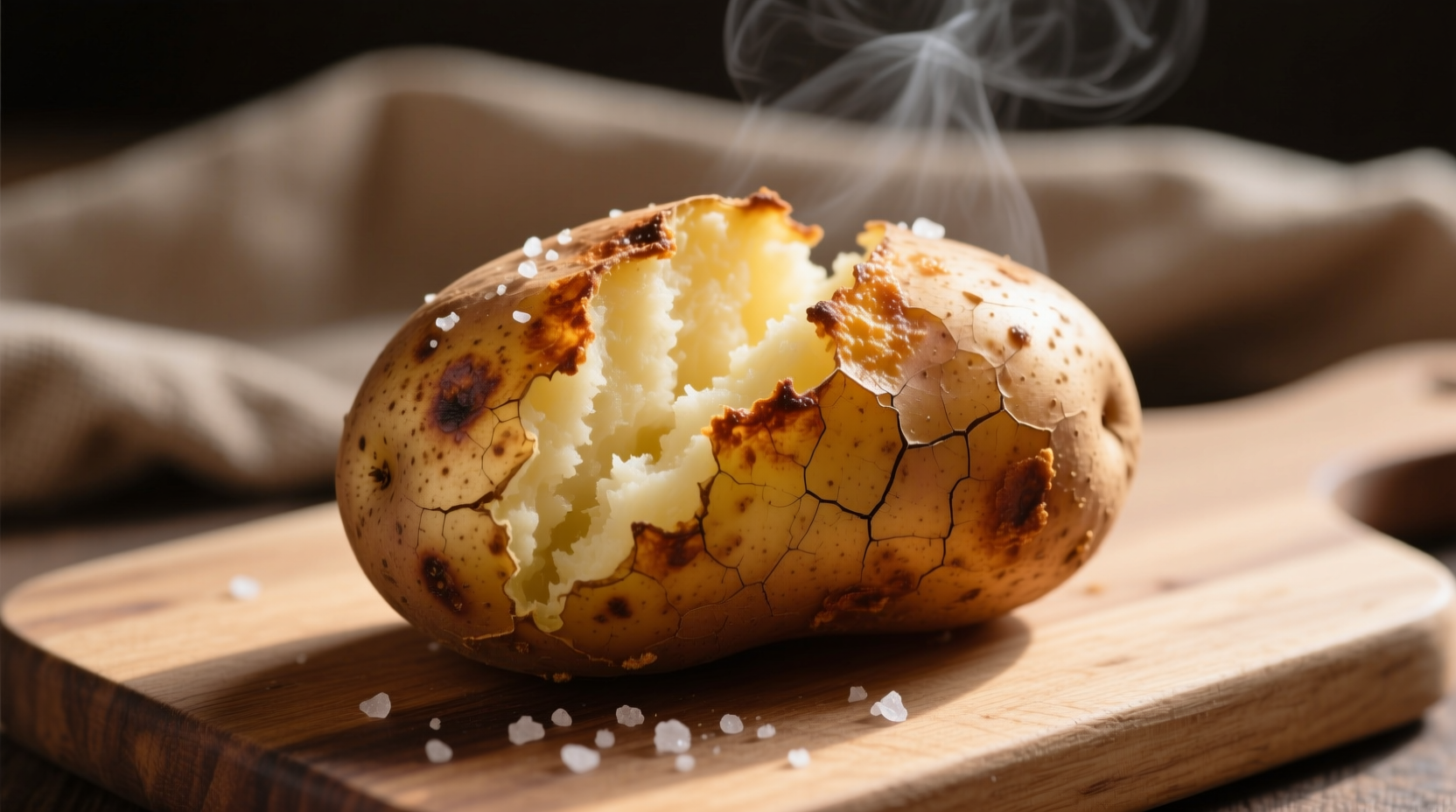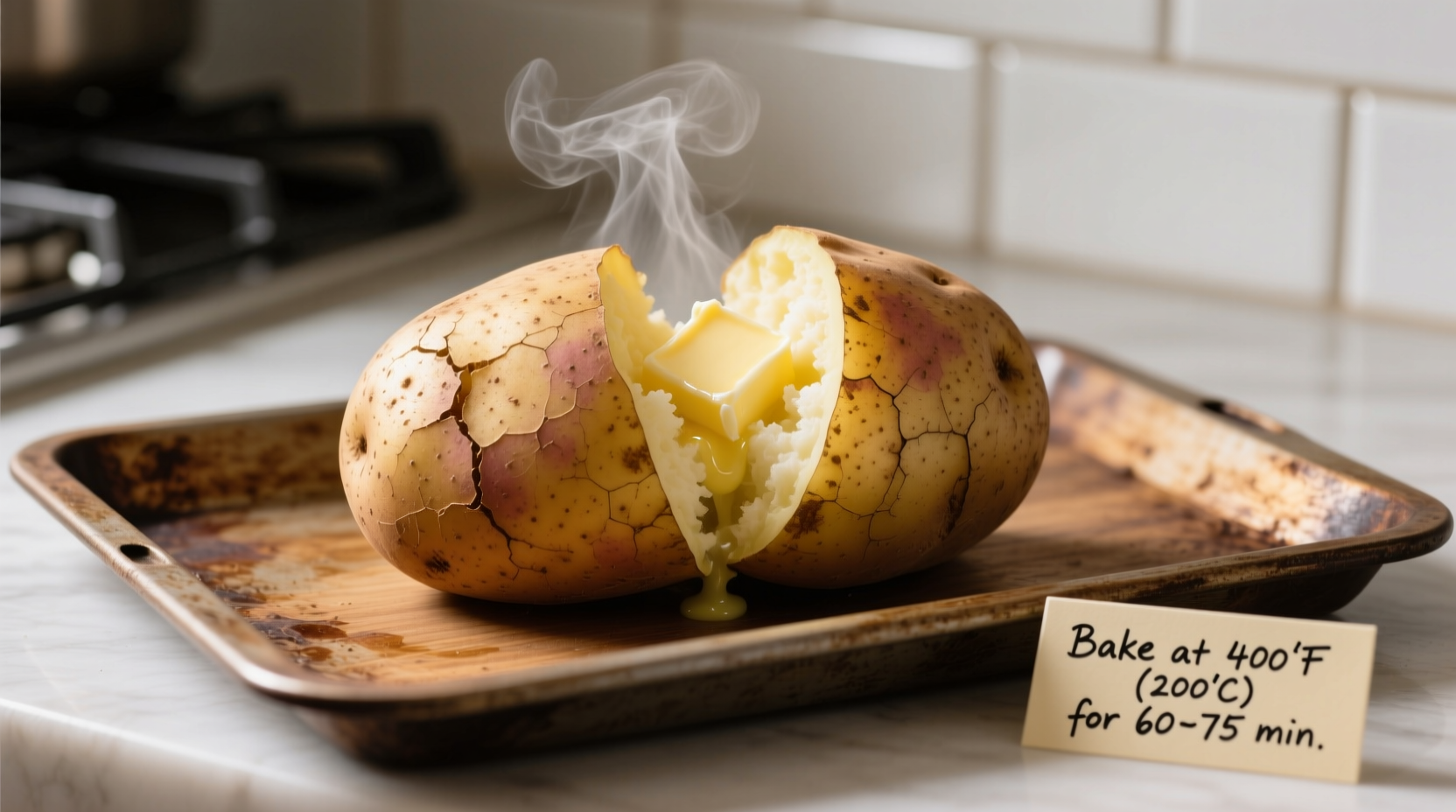The perfect baked potato requires a russet potato, 400°F oven temperature, and 45-60 minutes baking time. Prick the skin, skip foil wrapping, and test doneness by internal temperature reaching 205-210°F for fluffy, fully cooked results every time.
Nothing beats the simple satisfaction of a perfectly baked potato straight from the oven. Whether you're preparing a weeknight dinner or elevating a special meal, mastering this kitchen staple delivers restaurant-quality results at home. Our tested method eliminates guesswork with precise timing, temperature control, and preparation techniques that guarantee fluffy interiors and crispy skins.
Why This Baking Method Works
Baking potatoes properly transforms their starch structure through controlled heat application. When heated to 205-210°F, potato starch granules fully gelatinize, absorbing maximum moisture for that signature fluffy texture. The USDA Food Safety and Inspection Service confirms this temperature range ensures complete cooking while maintaining food safety standards (USDA Food Safety Temperatures).
| Potato Type | Size Category | Recommended Baking Time | Internal Temp Target |
|---|---|---|---|
| Russet | Medium (8-10 oz) | 45-55 minutes | 205-210°F |
| Russet | Large (12-16 oz) | 55-65 minutes | 205-210°F |
| Sweet Potato | Medium | 50-60 minutes | 200-205°F |
| Yukon Gold | Medium | 40-50 minutes | 200-205°F |
Step 1: Potato Selection and Preparation
Choose uniform russet potatoes with smooth, firm skins free from green spots or sprouts. Medium-sized potatoes (8-10 ounces) provide the most consistent results. Larger potatoes often develop uneven textures with overcooked exteriors and undercooked centers.
Thoroughly wash potatoes under cold running water using a vegetable brush to remove dirt. Contrary to popular belief, never soak potatoes as this introduces excess moisture that steams rather than bakes the skin. Pat completely dry with paper towels - moisture on the skin prevents crispiness.
Using a fork, prick each potato 6-8 times around its circumference. This critical step allows steam to escape during baking, preventing potentially dangerous explosions in your oven. Skip this step at your peril - pressure buildup from trapped steam can cause potatoes to burst violently.
Step 2: Oven Setup and Placement
Preheat your oven to 400°F with the rack positioned in the center. This temperature balances cooking speed with texture development - lower temperatures extend cooking time unnecessarily while higher temperatures risk burning the exterior before the interior cooks through.
Place potatoes directly on the oven rack with a baking sheet on the rack below to catch any drips. This allows hot air circulation around all sides for even cooking. For crispier skins, rub each potato lightly with olive oil and sprinkle with coarse salt before baking. Avoid aluminum foil wrapping - this steams the potato rather than baking it, resulting in soggy skin and less flavorful flesh.

Step 3: Monitoring and Testing Doneness
Set a timer for 45 minutes for medium potatoes, but don't rely solely on time. Begin checking at the minimum time using these professional doneness tests:
- Internal temperature: Insert an instant-read thermometer into the thickest part. Perfect doneness occurs at 205-210°F for russets.
- Squeeze test: Using oven mitts, gently squeeze the potato. It should yield slightly with no hard spots.
- Visual cues: Skin appears slightly wrinkled with no green spots, and the potato feels light for its size.
Undercooked potatoes remain dense and starchy, while overcooked potatoes develop dry, crumbly textures. The ideal baked potato maintains structural integrity while offering cloud-like fluffiness when scooped.
Step 4: Resting and Serving
Remove potatoes from the oven and let rest for 5-7 minutes. This crucial resting period allows residual heat to complete the cooking process while starches set for optimal texture. Cutting too soon releases trapped steam, making the interior gummy.
To serve, slice lengthwise and fluff the interior with a fork. Add butter, salt, and pepper for classic preparation, or experiment with these professional chef recommendations:
- Chive and sour cream for traditional flavor
- Crispy bacon and sharp cheddar for indulgence
- Garlic-infused olive oil and rosemary for Mediterranean flair
- Black beans and salsa for Southwest style
Troubleshooting Common Baking Issues
Problem: Soggy skin
Solution: Ensure potatoes are completely dry before baking and avoid foil wrapping. For extra-crispy skin, increase oven temperature to 425°F during the last 10 minutes of cooking.
Problem: Uneven cooking
Solution: Rotate potatoes halfway through baking time. For multiple potatoes, arrange them with space between each to ensure proper air circulation.
Problem: Hard center
Solution: Increase baking time and verify internal temperature reaches minimum 205°F. Larger potatoes may need 65-75 minutes at 400°F.
When to Choose Alternative Methods
While oven baking delivers superior texture, certain situations call for alternative approaches:
- Time constraints: Microwave for 5-7 minutes to partially cook, then finish in 400°F oven for 15 minutes for reasonably crispy skin.
- Large gatherings: Use a slow cooker on high for 3-4 hours for hands-off preparation (though skin won't crisp).
- Crispiness priority: For maximum crunch, bake at 425°F for 50-60 minutes with oil-rubbed skins.
Remember that baking times vary significantly based on oven calibration, potato size, and starting temperature. Always verify doneness with a thermometer rather than relying solely on time estimates.











 浙公网安备
33010002000092号
浙公网安备
33010002000092号 浙B2-20120091-4
浙B2-20120091-4